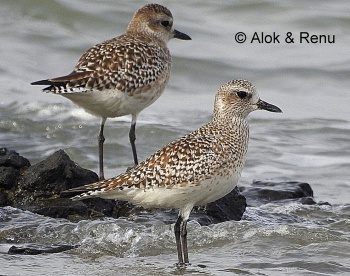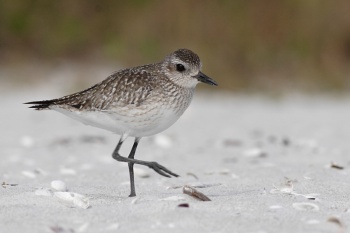Alternative name: Black-bellied Plover
- Pluvialis squatarola
Identification

Photo by Alok Tewari
Jamnagar, Coastal Gujarat, India, December-2017
27–31 cm(10½-12¼ in)
A large, compact Pluvialis plover with totally white undertail coverts. Shows black axillaries ("wingpits") in all plumages and a big, strong bill. Has a tiny hind toe which the other Pluvialis plovers lack.
In breeding plumage has upperside metallic bicoloured back with black and white spots, and front black from eyes down to between the legs; the black area is adjacent to a broad white band from forecrown to upper breast, but the black area disappears behind the wings by the lower breast. Males have slightly more extensive and solid black than females.
In winter plumage shows streaking on breast and less strongly patterned upperside, which is rather coldly coloured. The supercilium is quite prominent.
Juvenile has streaked breast and pale cap, and can show quite strongly yellowish colours.
In flight, the white uppertail coverts (appears as a "white rump"), barred tail, black axillaries ("armpits" or "wingpits") and bold white wing stripe are evident.
Similar Species
The other Pluvialis species (the three golden plovers) are slightly smaller with smaller head, thinner bill, and have dark tail, a less obvious or no wing stripe, and white or grey, not black, axillaries.
Distribution
Breeds between 65°N and 75°N in the Arctic Tundra (north-eastern Europe, northern Asia and northern Canada). The non-breeding range includes almost all coastlines between 50°N and 40°S; also wintering north to 60°N in NW Europe.
Taxonomy
This is considered a monotypic species by some authors[1], while other authorities recognise three subspecies, nominate P. s. squatarola (Europe, Asia, Alaska), P. s. cynosurae (North America except Alaska; marginally smaller) and P. s. tomkovichi (Wrangel Island in north-eastern Asia; marginally larger)[3], [4].
In the past, the species was occasionally split from Pluvialis into its own genus Squatarola, but this is no longer accepted[2].
Habitat
Breeds in arctic tundra without trees, winters on muddy and sandy areas almost exclusively along coasts.
Behaviour
All Pluvialis plovers have a habit of occasionally lifting their wings straight up without actually flying off, which helps a lot with seeing the colour of the axillaries.
Diet
Their rather varied diet consists of insects, larvae and other invertebrates such as beetles. Also some plant material like grass seeds and stems.
Vocalisation
Gallery
Click on photo for larger image
Photo by Ken Doy
Wellington Point, Brisbane, Queensland, October 2017Early Autumn plumage
Photo by birdthing
Titchwell Marsh, Norfolk, September 2017
References
- Clements, J. F., T. S. Schulenberg, M. J. Iliff, D. Roberson, T. A. Fredericks, B. L. Sullivan, and C. L. Wood. 2017. The eBird/Clements checklist of birds of the world: v2017, with updates to August 2017. Downloaded from http://www.birds.cornell.edu/clementschecklist/download/
- Del Hoyo, J, A Elliot, and J Sargatal, eds. 1996. Handbook of the Birds of the World. Volume 3: Hoatzin to Auks. Barcelona: Lynx Edicions. ISBN 978-8487334207
- Gill, F and D Donsker (Eds). 2014. IOC World Bird Names (version 4.3). Available at http://www.worldbirdnames.org/.
- Cramp, S. (ed.) Birds of the Western Palearctic 3: 216-226 (1983).
Recommended Citation
- BirdForum Opus contributors. (2025) Grey Plover. In: BirdForum, the forum for wild birds and birding. Retrieved 26 April 2025 from https://www.birdforum.net/opus/Grey_Plover
External Links
GSearch checked for 2020 platform.1









